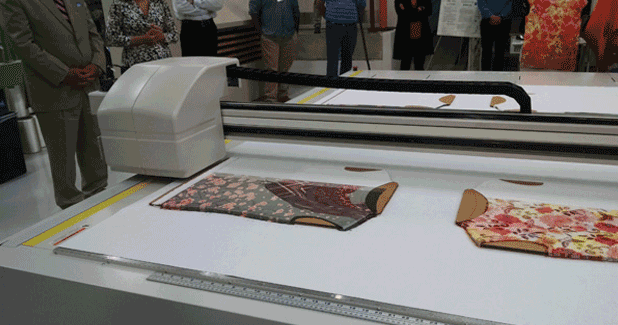
Digital printing market set for 17.9% growth
Globally, the digital textile printing market was valued at $1,245 million in 2015. It is estimated to reach $3,943 million by 2022, registering a CAGR of 17.9 per cent between 2016 and 2022.
Globally, the digital textile printing market was valued at $1,245 million in 2015. It is estimated to reach $3,943 million by 2022, registering a CAGR of 17.9 per cent between 2016 and 2022.
Digital textile printing is one of the latest and evolving printing technologies in the textiles industry. Since its commencement and commercialisation, the technology has been making waves and growing at a rapid pace. In the beginning, the technology was used for sampling and soft signage application because of limitations. As the technology progressed and advanced, it gained wide recognition and has been accepted by textile printers across the world. Today, this technology finds usage in a wide range of applications.
Digital printing is the act of printing digital images on a physical material. The material can be a paper, cloth, plastic or a film. Hence, digital textile printing refers to digital printing on cloth or fabric such as t-shirts, jackets, dresses, large format rolls of textile, and more. Digital textile printing uses the ink jet printing technology. The printing process incorporates feeding the fabric through the ink jet printer and applying the ink to the surface in the form of thousands of tiny droplets. The fabric is then finished using heat to cure the ink. The inks used in digital printing are on the basis of fibre used such as cotton, silk, polyester or nylon.
The global digital printing market is segmented based on ink type, substrate, application, and geography. On the basis of ink type, the market is categorised into acid, disperse, sublimation, pigment, reactive, and others. On the basis of substrate, it is segmented into cotton, silk, polyester, and others. By application, the market is divided into four important segments namely clothing/garments, households, technical textiles, display, and others. Geographically, the market has been analysed across key regions namely North America, Europe, Asia-Pacific, and LAMEA.
Future market forecast
Globally, the digital textile printing market was valued at $1,245 million in 2015. It is estimated to reach $3,943 million by 2022, registering a CAGR of 17.9 per cent between 2016 and 2022. The DTP market owes its financial growth to factors such as reduced response time, high design flexibility and creativity, short run cycles, and eco-friendly process. The rapid and lucrative market expansion is also due to evolving end user demands such as demand for rapid customisation, high-quality textile prints, and advertisements and corporate brandings, such as flags, retail graphics and banners.
Among all the regions, Europe is the expected to lead the market in the future, growing at a CAGR of 17.9 per cent, in terms of volume. Asia-Pacific is also expected to register steady growth rates. In 2015, Asia-Pacific and LAMEA accounted for nearly half of the global market in terms of volume. On the basis of value, Australia is expected to register a CAGR of 19.6 per cent.
Some of the key players operating in the global digital textile printing market are JV Digital Printing, AM Printex, AGS Transact Technologies, Digitex India Inc, Fisher Textiles Inc, Dazian LLC, Dickson Coatings, Glen Raven Inc, China Dyeing Holdings Ltd and Mehler Texnologies. Other players include Brother Industries Ltd, Hollanders Printing Systems, Mimaki Engineering Co Ltd, Reggiani Macchine SPA, KT Corporation, Mutoh Industries Ltd and Huntsman Corporation.
In 2015, there have been a number of acquisitions in the digital textile market space. Some of them are:
- EFI acquired Reggiani Macchine, an Italian manufacturer of digital textile printing equipment.
- Epson made move into digital textile market with its purchase of Fratelli Robustelli S.r.l.
- Sensient Technologies Corporation, a company based in Wisconsin, acquired Xennia Technology Ltd, a UK manufacturer of specialty inks used in digital printing.
- Dover Corporation acquired JK Group SPA and its three ink subsidiaries – J-Teck, Kiian Digital and Sawgrass.
Digital printing is one of the greatest developments in the textile industry. It allows much scope for customisation, small run printing, prototyping, and experimentation. With great potential for growth, the digital textile printing industry has excellent new opportunities in the market place and promises to maintain the growing demands of textile printing.
The feature is contributed by Ketki Vaze of www.alliedanalytics.com



